113 Painting Rack 10
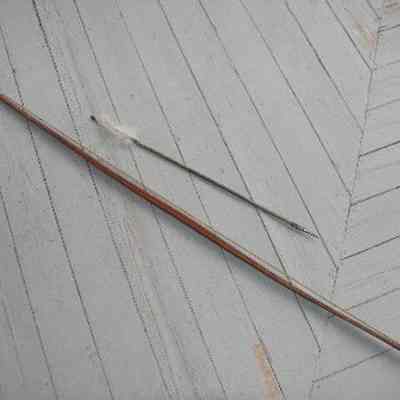

Bow
Name/Title
Bow
Lexicon
Description
Wooden, probably ash, bow with gut bowstring. Bow stave is rectangular with decorative groove and red painted stripes.
Acquisition
Source (if not Accessioned)
Abenaki Cultural Conservancy
Ethnography
Made/Created
Date made
circa 1760
Entry/Object ID
L2024.3.96
Context
The heavily oxidized bow is made from ash (CHECK THIS), rectangular in cross section, with a decorative groove incised on the sides and red ochre painted stripes. Structurally, the bow is in perfect shape complete with its original gut bowstring. It is stylistically different than other known bows from the region, and the only indicator of age is the gut bowstring, which probably phased out of use in the early 19th century in favor of Euroamerican vegetal cord. It is the only known really old Native style bow found in Vermont.
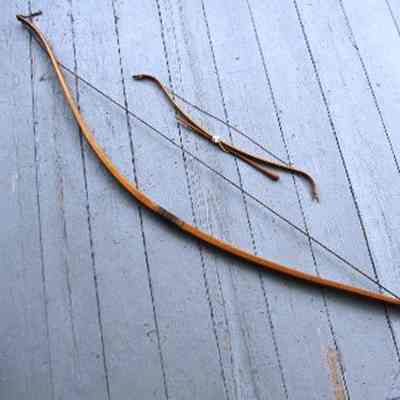

Bow
Name/Title
Bow
Lexicon
Description
Ash bow with bowstring through the bowstave
Acquisition
Source (if not Accessioned)
Abenaki Cultural Conservancy
Made/Created
Date made
circa 1900
Materials
Material
Ash
Entry/Object ID
L2024.3.97
Context
1890’s Southern Quebec “through the Bowstave” bow. This type of bow occasionally shows up in old lithographs and antique shops from Maine to Vermont. It is a strange arrangement, and it is unknown if it actually is more efficient than a regular recurved bow.
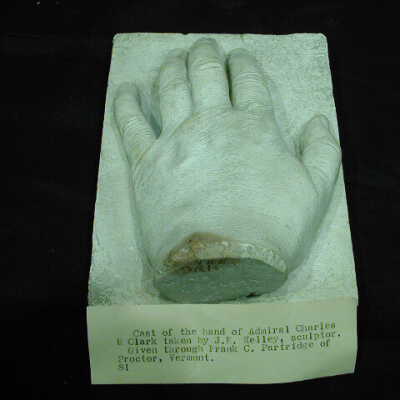

Casting
Name/Title
Casting
Lexicon
Description
Cast of a human hand on a rectangular base. The hand is cut off at the wrist, and the flat wrist portion is inscribed, "THE ORIGON CAPTAIN C.E. CLARK U.S.N. MARCH 29, 1902 / to WHITTEMORE FROM KELLY". There is a small loop inserted in the side for hanging.
Acquisition
Accession
1902.2
Relationships
Related Events
Spanish-American War
Event
Related Places
Place
Bradford
Town
Orange County
County
Vermont
State/Province
United States of America
Country
North America
Artwork Details
Medium
Plaster
Subject Person
Clark, Charles E. (1843-1922)
Made/Created
Artist Information
Kelly, J. E.
Artist
Date made
Mar 29, 1902
Dimensions
Dimension Description
Overall
Entry/Object ID
1902.2
Context
Admiral Charles Clark, along with fellow Vermont-born Admiral, George Dewey, had great fame in his lifetime. This casting was probably taken in the process of designing a sculpture. The note that accompanies the piece states that it was taken by the artist J. F. Kelley and came to VHS through Frank Partridge of Proctor, Vermont. Partridge was an executive with the Vermont Marble Company and would later to go on to serve as a U.S. Senator from Vermont.


Child's Bow
Name/Title
Child's Bow
Lexicon
Description
Child's size ash bow with bowstring through the bowstave
Acquisition
Source (if not Accessioned)
Abenaki Cultural Conservancy
Made/Created
Date made
circa 1900
Materials
Material
Ash
Entry/Object ID
L2024.3.98
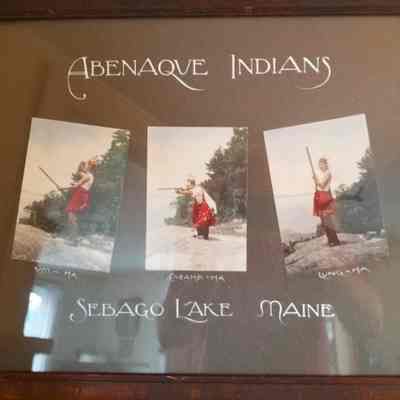

Collage "Abenaque Indians"
Name/Title
Collage "Abenaque Indians"
Lexicon
Description
Framed collage with three colorized photographs of an individual in native costume with a long gun. Work is titled, "Abenaque Indians" and subtitled, "Sebago Lake Maine." Costume includes large, red bag and feathered headdress. Background of large rocks, pine trees and water. (L-R) First photo shows person in profile holding gun at waist level and captioned "Um~Ha." Second photo shows person bent at waist in three-quarter view aiming gun over left wrist with caption, "Caramb~Ha." Third photo shows person facing to the left and looking at the camera, holding gun upright and captioned, "Lung~Ha."
Acquisition
Source (if not Accessioned)
Abenaki Cultural Conservancy
Artwork Details
Medium
Paper
Made/Created
Date made
1910-1930
Dimensions
Entry/Object ID
L2024.3.154
Context
This strange, (perhaps thought whimsical) framed collage is important for an early use of the “Abenaki” term in the hand drawn script designating a modern people. During the 18th can 19th centuries, “Abenaki” seemed to have only referred to historical peoples or as map designations. In Vermont, “Indian” and “St. Francis Indian” were the terms used for living regional indigenous people.
The three hand tinted photos illustrate a man with a muzzleloading firearm in three poses wearing a feather headdress and fragment of probably original cut cloth fringe clothing over a white shirt and trousers. Below the photos are constructed pseudo-Abenaki words.
The three hand tinted photos illustrate a man with a muzzleloading firearm in three poses wearing a feather headdress and fragment of probably original cut cloth fringe clothing over a white shirt and trousers. Below the photos are constructed pseudo-Abenaki words.
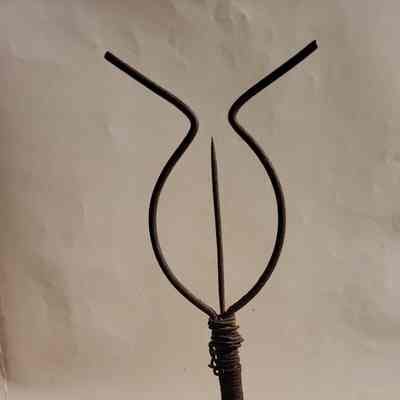

Fish Spear
Name/Title
Fish Spear
Lexicon
Description
Tubular steel fishing rod tipped with a sharp spring wire spike, flanked by two spring wire prongs.
Use
Fishing
Acquisition
Source (if not Accessioned)
Abenaki Cultural Conservancy
Ethnography
Made/Created
Date made
circa 1930
Materials
Material
Metal
Entry/Object ID
L2024.3.116
Context
This is a late example of an ancient trident fish spear style that is distinctive to the Wabanaki peoples. The central impaling spike is flanked by two “leads,” made from steel wire. This fishing spear was found in a garage sale in Newport, VT, a relic of local Native fishing systems. It is a recycled, tubular steel fishing rod tipped with a sharp spring wire spike, flanked by two spring wire prongs. It is wired together steel wire… This is a diminutive version of the highly distinctive Wabanaki fish spear executed in metal rather than wood. (Nulhegan Band 2010 Recognition Petition: 42)
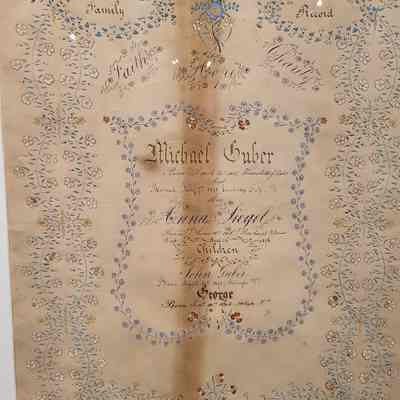

Guber Family Record
Name/Title
Guber Family Record
Lexicon
Description
The main text is enclosed in a shield that is made up of blue floral vine. Around the shield are interweaving floral vines. the top center has a small floral (blues and creames) arrangement. The bottom has a red heart with flowers coming out of the top center.
Acquisition
Accession
1991.8
Relationships
Related Person or Organization
Guber, Michael J. (1862-1941), Siegel, Anna (1862-1896), Guber, John J. (1891-1914), Guber, George Thomas (1892-1965)
Artwork Details
Medium
Paper, Ink
Subject
Family of Michael Guber and Anna Siegel Guber
Made/Created
Date made
1889
Dimensions
Entry/Object ID
1991.8.1
Context
This family record of a German immigrant to Vermont memorializes a marriage. Space was left for the later addition of children. The style is similar to that of Fraktur, a Germanic illustration technique for memorializing life events. Michael Guber immigrated from what was then Bohemia, to Vermont at the age of 23. He met his wife, also an immigrant from Bohemia, and married in Cambridge, New York. Children John and George were born in Arlington, Vermont.
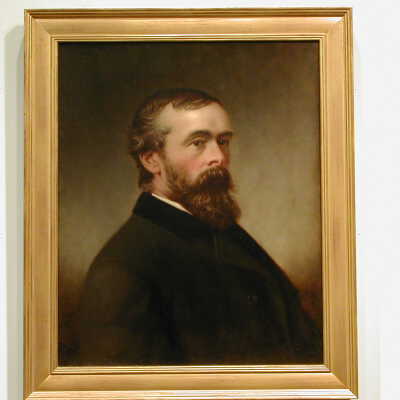

James S. Peck
Name/Title
James S. Peck
Type of Painting
Lexicon
Description
Portrait of a man facing 3/4 right. He is shown wearing a dark-color overcoat and has short brown hair and a narrow brown beard.
Acquisition
Accession
1920.9
Relationships
Related Places
Place
Montpelier
City
Washington County
County
Vermont
State/Province
United States of America
Country
North America
Artwork Details
Medium
Oil
Subject Person
Peck, James Stevens (1838-1884)
Made/Created
Artist Information
Wood, Thomas Waterman (1823-1903)
Artist
Dimensions
Dimension Description
Overall
Entry/Object ID
1920.9.1
Context
James S. Peck was Assistant State's Attorney for Vermont from 1869 to 1880.
The son of a cabinetmaker, Thomas Waterman Wood was born in Montpelier, Vermont in 1823. He showed an early aptitude for painting and was apprenticed to Boston portrait artist Chester Harding.
In 1850 he married and built a carpenter gothic summer home in Montpelier. For much of the ensuing decade he traveled throughout the U.S., Canada, and Europe while supporting himself through portrait painting.
Wood set up a permanent studio in New York City with a specialty on figure drawing. During and after the Civil War he started creating genre paintings which brought him national recognition. He was ultimately accepted in the National Academy of Design and served as its vice-president and president.
He continued to spend summers in Montpelier and considered Vermont his home. His portraits are very common throughout central Vermont with many held by the Vermont Historical Society. Upon his death he left funds to create the T.W. Wood Gallery in Montpelier. He chose to be buried in Montpelier's Green Mount Cemetery.
The son of a cabinetmaker, Thomas Waterman Wood was born in Montpelier, Vermont in 1823. He showed an early aptitude for painting and was apprenticed to Boston portrait artist Chester Harding.
In 1850 he married and built a carpenter gothic summer home in Montpelier. For much of the ensuing decade he traveled throughout the U.S., Canada, and Europe while supporting himself through portrait painting.
Wood set up a permanent studio in New York City with a specialty on figure drawing. During and after the Civil War he started creating genre paintings which brought him national recognition. He was ultimately accepted in the National Academy of Design and served as its vice-president and president.
He continued to spend summers in Montpelier and considered Vermont his home. His portraits are very common throughout central Vermont with many held by the Vermont Historical Society. Upon his death he left funds to create the T.W. Wood Gallery in Montpelier. He chose to be buried in Montpelier's Green Mount Cemetery.
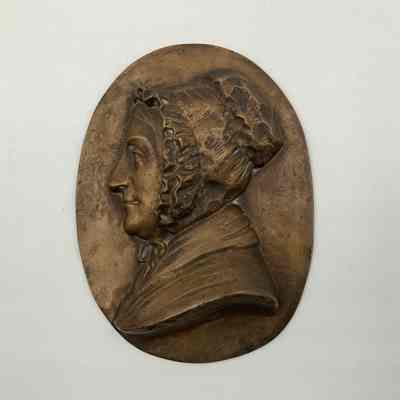

Jemima Leavitt
Name/Title
Jemima Leavitt
Description
Bas relief of Jemima Leavitt by William Morris Hunt. The carved relief shows Jemima facing proper right wearing a ruffled bonnet and high, simple collared dress. The relief is dated "1841" along the right lower edge.
There is a manufacturing company's name on the back but it is difficult to decipher. It may say "Gorham MFG Co."
Also on the back is the following: Jemima Loomis B. 1799 (which is an incorrect date. It should be 1779) M. Thaddeus Leavitt Jan. 1st 1801."
There is a manufacturing company's name on the back but it is difficult to decipher. It may say "Gorham MFG Co."
Also on the back is the following: Jemima Loomis B. 1799 (which is an incorrect date. It should be 1779) M. Thaddeus Leavitt Jan. 1st 1801."
Acquisition
Accession
2024.6
Relationships
Related Person or Organization
Hunt, William Morris (1824-1879)
Person or Organization
Related Places
Place
Brattleboro
Town
Windham County
County
Vermont
Connecticut
State/Province
United States of America
Country
North America
Continent
Artwork Details
Medium
Metal
Subject Person
Jemima Leavitt
Made/Created
Artist Information
Hunt, William Morris (1824-1879)
Artist
Date made
1841
Dimensions
Entry/Object ID
2024.6.7
Context
The subject of this bas relief was the grandmother of the artist. Jemima Loomis (1779-1846) of Connecticut married Thaddeus Leavitt (1778-1828 ) and they had two children, Jane and John Leavitt. Jane married Jonathon Hunt of Brattleboro, Vermont, and they had four children including William Morris Hunt.
"William Morris Hunt (born March 31, 1824, Brattleboro, Vermont, U.S.—died September 8, 1879, Isles of Shoals, New Hampshire) was a Romantic painter who created a fashion in the United States for the luminous, atmospheric painting of the French Barbizon school.
After attending Harvard University, Hunt studied with Thomas Couture in Paris and then in Barbizon with Jean-François Millet, one of the leaders of the Barbizon school of painters. Upon returning to New England, Hunt introduced the works of Camille Corot, Théodore Rousseau, and the Barbizon school to the Boston society circles in which he moved, thereby helping to turn a rising generation of American painters toward Paris and away from the national style epitomized by the Hudson River school landscape painters."
Source: https://www.britannica.com/biography/William-Morris-Hunt
"William Morris Hunt (born March 31, 1824, Brattleboro, Vermont, U.S.—died September 8, 1879, Isles of Shoals, New Hampshire) was a Romantic painter who created a fashion in the United States for the luminous, atmospheric painting of the French Barbizon school.
After attending Harvard University, Hunt studied with Thomas Couture in Paris and then in Barbizon with Jean-François Millet, one of the leaders of the Barbizon school of painters. Upon returning to New England, Hunt introduced the works of Camille Corot, Théodore Rousseau, and the Barbizon school to the Boston society circles in which he moved, thereby helping to turn a rising generation of American painters toward Paris and away from the national style epitomized by the Hudson River school landscape painters."
Source: https://www.britannica.com/biography/William-Morris-Hunt
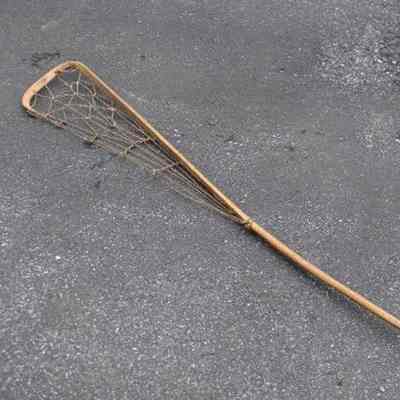

Lacrosse Stick
Name/Title
Lacrosse Stick
Lexicon
Description
Hooked, ash stick with woven rawhide basket
Use
Game of lacrosse
Acquisition
Source (if not Accessioned)
Abenaki Cultural Conservancy
Ethnography
Made/Created
Date made
circa 1870
Materials
Material
Ash, Rawhide
Entry/Object ID
L2024.3.115
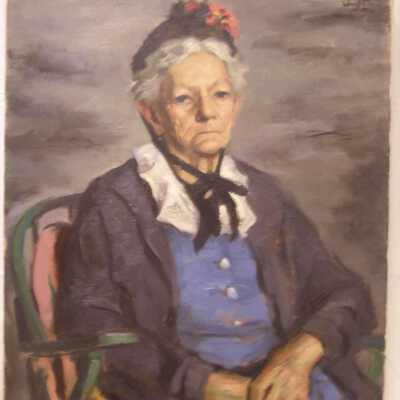

Old Gal
Name/Title
Old Gal
Type of Painting
Lexicon
Description
This portrait depicts an elderly woman seated in a green Windsor armchair with a yellow cushion, while a pink cushion rests against the chair's back. She is dressed in a blue dress with a white collar, accompanied by a darker blue jacket or sweater. Her head is adorned with a black hat decorated with pink flowers, secured by a loose black ribbon beneath her chin. The woman's hands are clasped together in her lap, and she wears a serious expression on her face. The background of the portrait is gray, and the artwork is unframed.
Acquisition
Accession
2006.46
Artwork Details
Medium
Oil
Subject Person
Small, Zana (1863-1952)
Made/Created
Artist Information
Wright, Stanley Marc (1911-1996)
Artist
Date made
circa 1938
Dimensions
Entry/Object ID
2006.46.5
Context
Entitle, "Old Gal," this portrait depicts Zana Bradley Small of Truro, Massachusetts. Dated 1938, the portrait was probably completed as part of Wright's work with the WPA. Zana Small was born in Highgate, Vermont but moved to Massachusetts at the time of her marriage in 1888. Little did Wright know at the time of the painting, that he would later become a full-time Vermonter and a great influence on the growing art community in that state.
Born and raised in New Jersey, Stan Marc Wright showed an early and consistent aptitude for art. Though he planned on following his father into the field of law, a trip to visit his aunt at an artist colony changed his life plans. He attended the Pratt Institute and graduated with honors in 1933, soon joining the Federal Art Project of the Works Progress Administration.
By the 1940s he was a sought-after portrait painter, famously depicting Ingrid Bergman. He enlisted in the army and served as a camouflage artist and portrait painter, ultimately earning a Bronze Star.
After the war he opened a studio and art school in New Jersey. After marrying Carolyne Hartke in 1949 the couple purchased an old farm in Stowe, Vermont. He moved his studio and school to Stowe and continued as a successful portrait artist.
He helped found the Northern Vermont Artists Association, the Helen Day Art Center, and curated many exhibitions. His portraits of Vermont politicians of the time are displayed in the Vermont State House. In addition to his Vermont portraits and scenes, he traveled the world painting interesting people and places.
Born and raised in New Jersey, Stan Marc Wright showed an early and consistent aptitude for art. Though he planned on following his father into the field of law, a trip to visit his aunt at an artist colony changed his life plans. He attended the Pratt Institute and graduated with honors in 1933, soon joining the Federal Art Project of the Works Progress Administration.
By the 1940s he was a sought-after portrait painter, famously depicting Ingrid Bergman. He enlisted in the army and served as a camouflage artist and portrait painter, ultimately earning a Bronze Star.
After the war he opened a studio and art school in New Jersey. After marrying Carolyne Hartke in 1949 the couple purchased an old farm in Stowe, Vermont. He moved his studio and school to Stowe and continued as a successful portrait artist.
He helped found the Northern Vermont Artists Association, the Helen Day Art Center, and curated many exhibitions. His portraits of Vermont politicians of the time are displayed in the Vermont State House. In addition to his Vermont portraits and scenes, he traveled the world painting interesting people and places.
Web Links and URLs
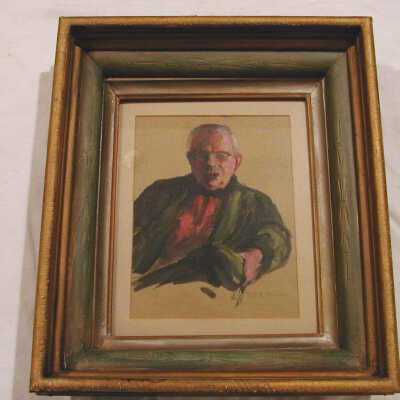

Willis Mould
Name/Title
Willis Mould
Lexicon
Description
Small portrait of a man wearing a green suit and red shirt. He has short white hair and glasses. He is shown seated with his legs crossed.
Acquisition
Accession
1998.22
Artwork Details
Medium
Oil
Subject Person
Mould, Willis Perry (1892-1961)
Made/Created
Artist Information
Mould, Ruth Greene (1894-1979)
Artist
Dimensions
Entry/Object ID
1998.22.14
Context
Vermont portrait artist Ruth G. Mould was born in Morrisville, Vermont on May 22, 1894. She was a graduate of local schools, Peoples Academy and Johnson Normal School, which prepared her for an early career as a teacher in the Cadys Falls district school house, teaching Grades 1 - 8. The visual arts, however, commanded her interest as a young woman, and an uncle sponsored her further studies at the Institute of Art in St. Paul, Minnesota, from which she graduated with honors. From there, she went on to study at the Art Students League in New York City, before she married Willis Mould in 1919, and returned to Vermont.
Throughout her married life and beyond, whether she was teaching art students at Johnson Normal School, tutoring private art students, and while she was raising her son, Channing, Ruth Mould's husband made sure she had her own private art studio wherever his work as a mining engineer took his family. They lived in Vermont in Morristown, Monkton, Johnson, Williamstown and Barre, and in New York State in Keysville.
Mould was one of two artists whose work represented the State of Vermont at the 1939 World's Fair in New York. However, she was best known for her portraits, including a posthumous portrait of Edna Beard, first female member of both the Vermont House and Senate, which hangs in the State House, and portraits of three Vermont Chief Justices in the Vermont Supreme Court Building.
In addition to some book illustration, Mould also wrote a book on Refinishing and Decorating Furniture (1953.) She was a member of the Northern Vermont Artist Association and an honorary lifetime member of the Art Students League in New York.
Ruth Mould died on February 13, 1979.
Throughout her married life and beyond, whether she was teaching art students at Johnson Normal School, tutoring private art students, and while she was raising her son, Channing, Ruth Mould's husband made sure she had her own private art studio wherever his work as a mining engineer took his family. They lived in Vermont in Morristown, Monkton, Johnson, Williamstown and Barre, and in New York State in Keysville.
Mould was one of two artists whose work represented the State of Vermont at the 1939 World's Fair in New York. However, she was best known for her portraits, including a posthumous portrait of Edna Beard, first female member of both the Vermont House and Senate, which hangs in the State House, and portraits of three Vermont Chief Justices in the Vermont Supreme Court Building.
In addition to some book illustration, Mould also wrote a book on Refinishing and Decorating Furniture (1953.) She was a member of the Northern Vermont Artist Association and an honorary lifetime member of the Art Students League in New York.
Ruth Mould died on February 13, 1979.
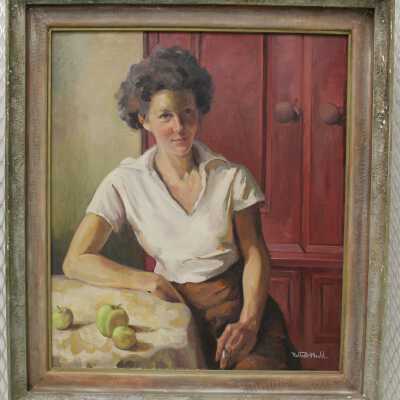

Woman with Cigarette
Name/Title
Woman with Cigarette
Lexicon
Description
Portrait of a woman in with brown hair, wearing a white shirt and brown skirt seated at a table in front of a large, red cupboard. The woman leans her right arm on the table while the left hand holds a cigarette. The table has an off-white, patterned tablecloth and holds three green apples.
Acquisition
Accession
1998.22
Artwork Details
Medium
Oil on Canvas
Made/Created
Artist Information
Mould, Ruth Greene (1894-1979)
Artist
Date made
1940-1955
Dimensions
Entry/Object ID
1998.22.15
Context
Vermont portrait artist Ruth G. Mould was born in Morrisville, Vermont on May 22, 1894. She was a graduate of local schools, Peoples Academy and Johnson Normal School, which prepared her for an early career as a teacher in the Cadys Falls district school house, teaching Grades 1 - 8. The visual arts, however, commanded her interest as a young woman, and an uncle sponsored her further studies at the Institute of Art in St. Paul, Minnesota, from which she graduated with honors. From there, she went on to study at the Art Students League in New York City, before she married Willis Mould in 1919, and returned to Vermont.
Throughout her married life and beyond, whether she was teaching art students at Johnson Normal School, tutoring private art students, and while she was raising her son, Channing, Ruth Mould's husband made sure she had her own private art studio wherever his work as a mining engineer took his family. They lived in Vermont in Morristown, Monkton, Johnson, Williamstown and Barre, and in New York State in Keysville.
Mould was one of two artists whose work represented the State of Vermont at the 1939 World's Fair in New York. However, she was best known for her portraits, including a posthumous portrait of Edna Beard, first female member of both the Vermont House and Senate, which hangs in the State House, and portraits of three Vermont Chief Justices in the Vermont Supreme Court Building.
In addition to some book illustration, Mould also wrote a book on Refinishing and Decorating Furniture (1953.) She was a member of the Northern Vermont Artist Association and an honorary lifetime member of the Art Students League in New York.
Ruth Mould died on February 13, 1979.
Throughout her married life and beyond, whether she was teaching art students at Johnson Normal School, tutoring private art students, and while she was raising her son, Channing, Ruth Mould's husband made sure she had her own private art studio wherever his work as a mining engineer took his family. They lived in Vermont in Morristown, Monkton, Johnson, Williamstown and Barre, and in New York State in Keysville.
Mould was one of two artists whose work represented the State of Vermont at the 1939 World's Fair in New York. However, she was best known for her portraits, including a posthumous portrait of Edna Beard, first female member of both the Vermont House and Senate, which hangs in the State House, and portraits of three Vermont Chief Justices in the Vermont Supreme Court Building.
In addition to some book illustration, Mould also wrote a book on Refinishing and Decorating Furniture (1953.) She was a member of the Northern Vermont Artist Association and an honorary lifetime member of the Art Students League in New York.
Ruth Mould died on February 13, 1979.